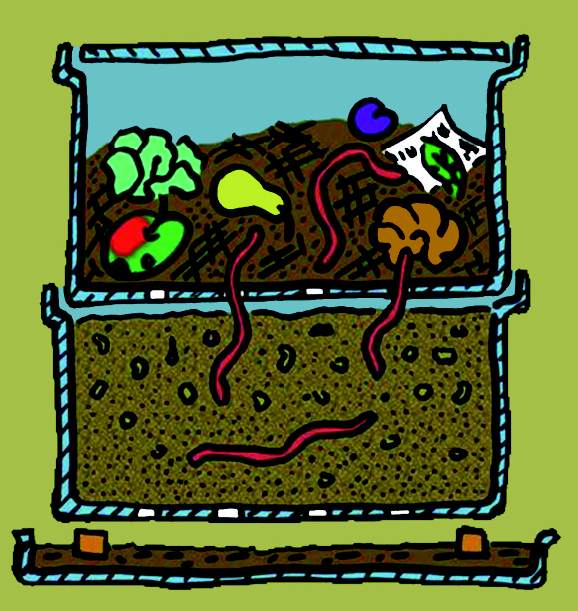Wormery
A wormery transforms organic kitchen waste into high quality compost.It's a great way to keep nutrients in your system and supply part of your own soil.
The wormery consists of several levels, e.g. boxes stacked on one another.You add fresh material on the top, the finished compost can be harvested from the lower levels. Fluids (worm tea, or worm castings tea) trickle all the way down, where you can then collect it.

Illus.1: Schema of a Womery
Worms as Pets
Loading
Benefits of the Wormery
Contrary to other methods of composting, the worms convert the organic material without heat. Worms can eat up to their weight every day and are very effective composters. The worm castings (vermicast) and the worm tea contain nitrogen, phosphorus and potassium and are excellent fertilizers.
Worm tea is diluted with a proportion of 1:10 with water and applied with a watering can.
The worm compost is also mixed with a proportion of 1:10 with potting soil or spread directly on the beds, or mixed with the soil.
The Worms
The redworm (Eisenia foetida, Red wiggler worm) is one of the most active species of earthworms. Worms breathe through their skin. They do not have teeth, but small stones in their stomachs. The can get as old as over 10 years and reproduce quickly. They stop reproduction when the population is too high, when there is too little food available, or when the temperatures are too low (30°).

Illus.2: Redworms
Handling
The wormery should be protected from sun, wind and rain. Because it is visited often it should be placed close by in [Zone 1]. There are variations of the wormery that are very suitable for living spaces.Worms prefer temperatures between 10 and 30°C, do not like light and need enough oxygen.In the wintertime they have to be fed and protected from the frost, or released into the ground.The redworms eat all kinds of plant matter that is soft enough. Crushed eggshells and up to 20% paper and cardboard can also be added, especially when the compost gets too moist.Meat, cooked vegetables and citrus fruits should be avoided.
Two weeks vacation are no problem for the worms, if you feed them enough before you leave.
Structure of the Wormery
The lowest level collects the worm tea. It is not filled with organic matter.The next level is filled with newspaper, cardboard cuttings and hay. This is where you add the worms and start feeding them. The fresh material can be sprinkled with rock dust and should be covered with newspaper or a felt mat.
If you overfeed the worms, the wormery can start rotting and might smell. If you have 250 g of worms, it's enough to add 200 g of organic matter per day. If they reproduce quickly, you can add more.
The worms need a humid environment. You can add water if it is too dry or add newspaper or leaves if it is to wet.
When the first layer is full, start to fill the next layer with food. The worms will then migrate to the top. Continue this process.
The wormery should be covered.
The horizontal wormery
An old bathtub can be used as a horizontal wormery. Here you work from one end to the other. In the middle, put a separating wall with holes for the worms to crawl through. Fresh material is added to one side at a time. When it is full, you harvest the compost from the other side and start again.The active side is covered with a felt mat or an old carpet. The whole wormery is protected from the elements with a cover.You can use the drain of the bathtub to collect the worm tea in a bucket.It is a good idea to aerate the wormery with a garden fork from time to time.
Loading
Sources
Big parts of the article, as well as images and graphics were taken from "Die kleine Permakultur-Fibel" by Bernhard Gruber and changed.
Illus.2: Wikimedia Commons: Compost with earthworms by the Sustainable Sanitation Alliance
Video: Vimeo.com: Red Wigglers / Vermicomposting by Allison Egdahl (Thank you!)